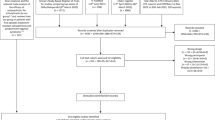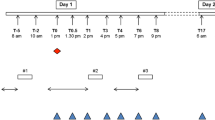Abstract
For currently available antipsychotic drugs, blockade of dopamine D2 receptors is a critical component for achieving antipsychotic efficacy, but it is also a driving factor in the development of extrapyramidal symptoms (EPS). To inform the clinical development of asenapine, generic mathematical models have been developed for predicting antipsychotic efficacy and EPS tolerability based on D2 receptor occupancy. Clinical data on pharmacokinetics, D2 receptor occupancy, efficacy, and EPS for several antipsychotics were collected from the public domain. Asenapine data were obtained from in-house trials. D2 receptor occupancy data were restricted to published positron emission tomography studies that included blood sampling for pharmacokinetics. Clinical efficacy data were restricted to group mean endpoint data from short-term placebo-controlled trials, whereas EPS evaluation also included some non-placebo-controlled trials. A generally applicable model connecting antipsychotic dose, pharmacokinetics, D2 receptor occupancy, Positive and Negative Syndrome Scale (PANSS) response, and effect on Simpson–Angus Scale (SAS) was then developed. The empirical models describing the D2–PANSS and D2–SAS relationships were used successfully to aid dose selection for asenapine phase II and III trials. A broader use can be envisaged as a dose selection tool for new antipsychotics with D2 antagonist properties in the treatment of schizophrenia.






Similar content being viewed by others
References
Lieberman JA. Effectiveness of antipsychotic drugs in patients with chronic schizophrenia: efficacy, safety and cost outcomes of CATIE and other trials. J Clin Psychiatry. 2007;68:e04.
Kapur S, Zipursky RB, Remington G. Clinical and theoretical implications of 5-HT2 and D2 receptor occupancy of clozapine, risperidone, and olanzapine in schizophrenia. Am J Psychiatry. 1999;156:286–93.
Farde L, Nordstrom AL, Wiesel FA, Pauli S, Halldin C, Sedvall G. Positron emission tomographic analysis of central D1 and D2 dopamine receptor occupancy in patients treated with classical neuroleptics and clozapine. Relation to extrapyramidal side effects. Arch Gen Psychiatry. 1992;49:538–44.
Pani L, Pira L, Marchese G. Antipsychotic efficacy: relationship to optimal D(2)-receptor occupancy. Eur Psychiatry. 2007;22:267–75.
Kapur S, Remington G, Jones C, Wilson A, DaSilva J, Houle S, et al. High levels of dopamine D2 receptor occupancy with low-dose haloperidol treatment: a PET study. Am J Psychiatry. 1996;153:948–50.
Nordstrom AL, Farde L, Wiesel FA, Forslund K, Pauli S, Halldin C, et al. Central D2-dopamine receptor occupancy in relation to antipsychotic drug effects: a double-blind PET study of schizophrenic patients. Biol Psychiatry. 1993;33:227–35.
Horacek J, Bubenikova-Valesova V, Kopecek M, Palenicek T, Dockery C, Mohr P, et al. Mechanism of action of atypical antipsychotic drugs and the neurobiology of schizophrenia. CNS Drugs. 2006;20:389–409.
Saphris® (asenapine sublingual tablets). Full prescribing information, Schering Corporation, a subsidiary of Merck & Co., Inc, Whitehouse Station, NJ; 2010.
European Medicines Agency. Sycrest asenapine. 2010. http://www.ema.europa.eu/ema/index.jsp?curl=pages/medicines/human/medicines/001177/human_med_001379.jsp&murl=menus/medicines/medicines.jsp&mid=WC0b01ac058001d124&jsenabled=true. Accessed 28 September 2010.
Shahid M, Walker GB, Zorn SH, Wong EH. Asenapine: a novel psychopharmacologic agent with a unique human receptor signature. J Psychopharmacol. 2009;23:65–73.
Andree B, Halldin C, Vrijmoed-de Vries M, Farde L. Central 5-HT2A and D2 dopamine receptor occupancy after sublingual administration of ORG 5222 in healthy men. Psychopharmacology Berl. 1997;131:339–45.
Data on file. Summit, NJ: Merck; 2010.
Geodon® (ziprasidone). Full prescribing information, Pfizer Inc., New York, NY; 2009.
Cheng YF, Paalzow LK, Bondesson U, Ekblom B, Eriksson K, Eriksson SO, et al. Pharmacokinetics of haloperidol in psychotic patients. Psychopharmacology Berl. 1987;91:410–4.
Heyden S. Risperidone expert report (Serial No. R64 766). April 1992.
Kay SR, Fiszbein A, Opler LA. The Positive and Negative Syndrome Scale (PANSS) for schizophrenia. Schizophr Bull. 1987;13:261–76.
Simpson GM, Angus JW. A rating scale for extrapyramidal side effects. Acta Psychiatr Scand Suppl. 1970;212:11–9.
Risperdal® (risperidone). Full prescribing information. Janssen, Division of Ortho-McNeil-Janssen Pharmaceuticals, Inc., Titusville, NJ; 2009.
Zyprexa. Eli Lilly and Company, Indianapolis, IN; 2010.
Friberg LE, de Greef R, Kerbusch T, Karlsson MO. Modeling and simulation of the time course of asenapine exposure response and dropout patterns in acute schizophrenia. Clin Pharmacol Ther. 2009;86:84–91.
Kapur S, Zipursky R, Jones C, Remington G, Houle S. Relationship between dopamine D(2) occupancy, clinical response, and side effects: a double-blind PET study of first-episode schizophrenia. Am J Psychiatry. 2000;157:514–20.
Kane JM, Cohen M, Zhao J, Alphs L, Panagides J. Efficacy and safety of asenapine in a placebo- and haloperidol-controlled trial in patients with acute exacerbation of schizophrenia. J Clin Psychopharmacol. 2010;30:106–15.
Meltzer HY, Li Z, Kaneda Y, Ichikawa J. Serotonin receptors: their key role in drugs to treat schizophrenia. Prog Neuropsychopharmacol Biol Psychiatry. 2003;27:1159–72.
Reynolds GP, Yao Z, Zhang X, Sun J, Zhang Z. Pharmacogenetics of treatment in first-episode schizophrenia: D3 and 5-HT2C receptor polymorphisms separately associate with positive and negative symptom response. Eur Neuropsychopharmacol. 2005;15:143–51.
Lieberman JA, Mailman RB, Duncan G, Sikich L, Chakos M, Nichols DE, et al. Serotonergic basis of antipsychotic drug effects in schizophrenia. Biol Psychiatry. 1998;44:1099–117.
Lane HY, Lee CC, Liu YC, Chang WH. Pharmacogenetic studies of response to risperidone and other newer atypical antipsychotics. Pharmacogenomics. 2005;6:139–49.
Farde L, Nyberg S, Oxenstierna G, Nakashima Y, Halldin C, Ericsson B. Positron emission tomography studies on D2 and 5-HT2 receptor binding in risperidone-treated schizophrenic patients. J Clin Psychopharmacol. 1995;15:19S–23S.
Gefvert O, Bergstrom M, Langstrom B, Lundberg T, Lindstrom L, Yates R. Time course of central nervous dopamine-D2 and 5-HT2 receptor blockade and plasma drug concentrations after discontinuation of quetiapine (Seroquel) in patients with schizophrenia. Psychopharmacology Berl. 1998;135:119–26.
Gefvert O, Lundberg T, Wieselgren IM, Bergstrom M, Langstrom B, Wiesel F, et al. D(2) and 5HT(2A) receptor occupancy of different doses of quetiapine in schizophrenia: a PET study. Eur Neuropsychopharmacol. 2001;11:105–10.
Seeman P, Tallerico T. Antipsychotic drugs which elicit little or no parkinsonism bind more loosely than dopamine to brain D2 receptors, yet occupy high levels of these receptors. Mol Psychiatry. 1998;3:123–34.
Kapur S, Seeman P. Antipsychotic agents differ in how fast they come off the dopamine D2 receptors. Implications for atypical antipsychotic action. J Psychiatry Neurosci. 2000;25:161–6.
Potkin SG, Cohen M, Panagides J. Efficacy and tolerability of asenapine in acute schizophrenia: a placebo- and risperidone-controlled trial. J Clin Psychiatry. 2007;68:1492–500.
Nordstrom AL, Farde L, Halldin C. Time course of D2-dopamine receptor occupancy examined by PET after single oral doses of haloperidol. Psychopharmacology Berl. 1992;106:433–8.
Nyberg S, Farde L, Halldin C. A PET study of 5-HT2 and D2 dopamine receptor occupancy induced by olanzapine in healthy subjects. Neuropsychopharmacology. 1997;16:1–7.
Remington G, Kapur S, Zipursky R. The relationship between risperidone plasma levels and dopamine D2 occupancy: a positron emission tomographic study. J Clin Psychopharmacol. 1998;18:82–3.
Nyberg S, Farde L, Eriksson L, Halldin C, Eriksson B. 5-HT2 and D2 dopamine receptor occupancy in the living human brain. A PET study with risperidone. Psychopharmacology Berl. 1993;110:265–72.
Nyberg S, Eriksson B, Oxenstierna G, Halldin C, Farde L. Suggested minimal effective dose of risperidone based on PET-measured D2 and 5-HT2A receptor occupancy in schizophrenic patients. Am J Psychiatry. 1999;156:869–75.
Bench CJ, Lammertsma AA, Dolan RJ, Grasby PM, Warrington SJ, Gunn K, et al. Dose dependent occupancy of central dopamine D2 receptors by the novel neuroleptic CP-88, 059–01: a study using positron emission tomography and 11C-raclopride. Psychopharmacology Berl. 1993;112:308–14.
Bench CJ, Lammertsma AA, Grasby PM, Dolan RJ, Warrington SJ, Boyce M, et al. The time course of binding to striatal dopamine D2 receptors by the neuroleptic ziprasidone (CP-88, 059–01) determined by positron emission tomography. Psychopharmacology Berl. 1996;124:141–7.
Beasley Jr CM, Tollefson G, Tran P, Satterlee W, Sanger T, Hamilton S. Olanzapine versus placebo and haloperidol: acute phase results of the North American double-blind olanzapine trial. Neuropsychopharmacology. 1996;14:111–23.
Beasley Jr CM, Sanger T, Satterlee W, Tollefson G, Tran P, Hamilton S. Olanzapine versus placebo: results of a double-blind, fixed-dose olanzapine trial. Psychopharmacology Berl. 1996;124:159–67.
Beasley Jr CM, Hamilton SH, Crawford AM, Dellva MA, Tollefson GD, Tran PV, et al. Olanzapine versus haloperidol: acute phase results of the international double-blind olanzapine trial. Eur Neuropsychopharmacol. 1997;7:125–37.
Marder SR, Meibach RC. Risperidone in the treatment of schizophrenia. Am J Psychiatry. 1994;151:825–35.
Borison R, et al. Risperidone versus haloperidol versus placebo in the treatment of schizophrenia. Clinical Research Report No. RIS-USA-9001, N83170. Piscataway, NJ: Janssen; 1991.
Peuskens J. Risperidone in the treatment of patients with chronic schizophrenia: a multi-national, multi-centre, double-blind, parallel-group study versus haloperidol. Risperidone Study Group. Br J Psychiatry. 1995;166:712–26.
Clinical Report: RIS-USA-72. 1997. NDA 20588/S002.
Daniel DG, Zimbroff DL, Potkin SG, Reeves KR, Harrigan EP, Lakshminarayanan M. Ziprasidone 80 mg/day and 160 mg/day in the acute exacerbation of schizophrenia and schizoaffective disorder: a 6-week placebo-controlled trial. Ziprasidone Study Group. Neuropsychopharmacology. 1999;20:491–505.
Keck Jr P, Buffenstein A, Ferguson J, Feighner J, Jaffe W, Harrigan EP, et al. Ziprasidone 40 and 120 mg/day in the acute exacerbation of schizophrenia and schizoaffective disorder: a 4-week placebo-controlled trial. Psychopharmacology Berl. 1998;140:173–84.
Goff DC, Posever T, Herz L, Simmons J, Kletti N, Lapierre K, et al. An exploratory haloperidol-controlled dose-finding study of ziprasidone in hospitalized patients with schizophrenia or schizoaffective disorder. J Clin Psychopharmacol. 1998;18:296–304.
Clinical Report: Study 104. 1998. NDA 20825.
Clinical Report: Study 115. 1998. NDA 20825.
Arvanitis LA, Miller BG. Multiple fixed doses of “Seroquel” (quetiapine) in patients with acute exacerbation of schizophrenia: a comparison with haloperidol and placebo. The Seroquel Trial 13 Study Group. Biol Psychiatry. 1997;42:233–46.
Zimbroff DL, Kane JM, Tamminga CA, Daniel DG, Mack RJ, Wozniak PJ, et al. Controlled, dose–response study of sertindole and haloperidol in the treatment of schizophrenia. Sertindole Study Group. Am J Psychiatry. 1997;154:782–91.
Acknowledgments
The authors thank Dr. Shitij Kapur for his insights and direction during the early development of the models. All authors contributed to the development and writing of the paper and are completely responsible for its scientific content. This study was funded by Merck (Whitehouse Station, NJ, USA). Editorial support was provided by Complete Healthcare Communications, Inc., and funded by Merck (Whitehouse Station, NJ, USA).
Conflicts of interest
Rik de Greef and Joep Schoemaker are employees of Merck Sharp & Dohme (Oss, the Netherlands). John Panagides was an employee of Schering-Plough (formerly Organon), now Merck, at the time the study was conducted. Drs. Maloney and Olsson-Gisleskog were employed by Pharsight, A Certara Company, at the time this research was conducted and have no other interests to report.
Author information
Authors and Affiliations
Corresponding author
Electronic supplementary material
Below is the link to the electronic supplementary material.
Supplementary Table 1
(DOC 143 872 kb)
Rights and permissions
About this article
Cite this article
de Greef, R., Maloney, A., Olsson-Gisleskog, P. et al. Dopamine D2 Occupancy as a Biomarker for Antipsychotics: Quantifying the Relationship with Efficacy and Extrapyramidal Symptoms. AAPS J 13, 121–130 (2011). https://doi.org/10.1208/s12248-010-9247-4
Received:
Accepted:
Published:
Issue Date:
DOI: https://doi.org/10.1208/s12248-010-9247-4




